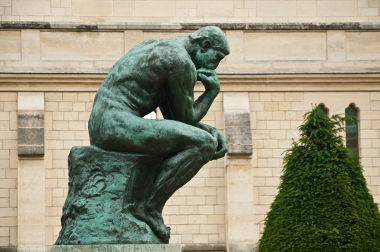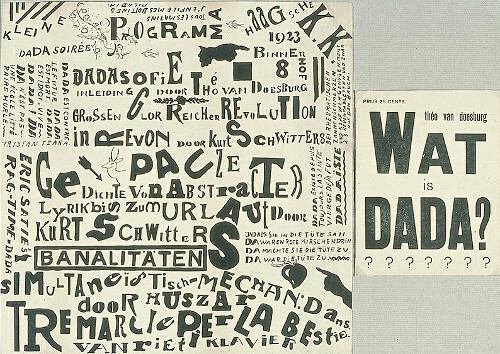The Arts test at Enem is formed by 5 questions. It is essential to assimilate knowledge in this area so that you have more chances of success in the test.
In addition, of course, to being an important understanding for the world to be reflected in a conscious and critical spirit.
question 1
(Enem-2018)
TEXT I

TEXT II
Body art puts the body so much in evidence and submits it to such varied experiments that its influence extends to the present day. If in current art the possibilities for investigating the body seem limitless - you can choose between represent, present, or even just evoke the body - this is thanks to the artists' legacy pioneers.
Silvia, P.R. Body in art, body art, body modification: borders. II Art History Meeting: IFCH-Unicamp 2006 (adapted)
In the texts, the concept of body art is related to the intention of:
a) establish boundaries between body and composition.
b) make the body a privileged support for expression.
c) discuss policies and ideologies about the body as art.
d) understand the autonomy of the body in the context of the work.
e) highlight the artist's body in contact with the viewer.
Correct alternative: b) make the body a privileged support for expression.
The artistic language body art - with Portuguese translation for "body art" - uses precisely as material and main support the artist's body, privileging it as a creative and expression.
a) INCORRECT. Composition is not included here as an element of analysis.
The Portuguese artist Helena Almeida (Text I), produced an extensive work in which she mainly uses the body as an elementary support, which is inherent to body art. In text II it is revealed that, in addition to painting and body design, the body itself can be used as an artistic support in a privileged way.
c) INCORRECT. The intention of body art is not to discuss policies and ideology about the body as art, but to use it as a tool to discuss various subjects, including the body.
d) INCORRECT. The work is not intended to understand the autonomy of the body, but to use it as a support.
e) INCORRECT. At no time was the relationship between the artist's body and the spectator clear.
question 2
(Enem-2018)
TEXT I
Also called photogrammatic prints or images […], photograms are, in a generic definition, images made without the use of the camera, by direct contact of an object or material with a photosensitive surface exposed to a source of light. This technique, which was born together with photography and served as a model for many discussions about the ontology of photographic image, was profoundly transformed by avant-garde artists in the first decades of the century XX. It even represented, alongside collages, photomontages and other technical procedures, the definitive incorporation of photography into modern art and its distance from figurative representation.
COLUCCI, M. B. Photogrammatic and avant-garde prints: Man Ray's experiences. Study, no. 2, 2000.
TEXT II
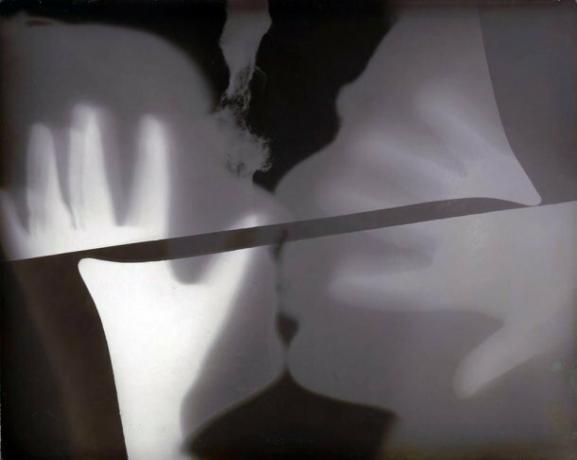
In Man Ray's frame, the "distancing from the figurative representation" referred to in Text I is manifested in:
a) resignification of the play of light and shadow, in surrealist molds.
b) imposition of chance over technique, as a criticism of realist art.
c) experimental composition, fragmented and with diffuse outlines.
d) radical abstraction, focused on the photographic language itself.
e) imitation of human forms, based on different objects.
Correct alternative: c) experimental composition, fragmented and with diffuse outlines.
THE rayography it appears in the history of art as an experimental process in which photographers/artists were creating new compositions, using as an instrument the elements that are part of the photographic universe.
a) INCORRECT. The games of "light and shadow" are part of the photographic language, but they were not an "innovation" or resignification for the surrealists.
b) INCORRECT. There was also no direct criticism of realist art. In addition, photomontages required the use of an artistic technique for their realization.
In the case of photomontages, the camera was not used, but the sensitive material and the laboratory where the photos were developed. There, they fragmented the images, experimenting and creating works without worrying about technical aspects such as sharpness and outline.
d) INCORRECT. The idea of this rayography was also not that of a "radical abstraction", it sought a "distancing from the figurative representation", as the text itself shows.
e) INCORRECT. This "distancing from the figurative representation" to which the text refers is more related to the photographic representation itself. In the case of Man Ray's photomontage, he even suggests "human forms", but not as in traditional photography.
question 3
(Enem-2018)
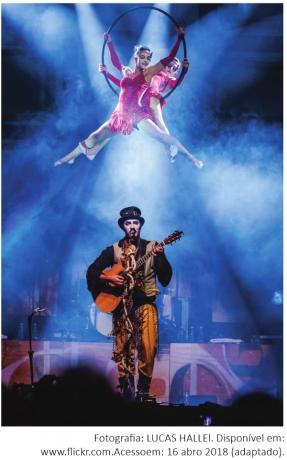
The group O Teatro Mágico presents authorial compositions that have aesthetic references to rock, pop and Brazilian folk music. The originality of her shows is related to 19th century European opera from:
a) scenic disposition of the artists in the theatrical space.
b) integration of different artistic languages.
c) overlap between music and literary text.
d) maintenance of a dialogue with the public.
e) adoption of a plot as a common thread.
Correct alternative: b) integration of different artistic languages.
The Teatro Mágico group is known for its performance performance and the mix of artistic strands. The question relates the group to 19th century opera, in this case the operettas, in which they also performed in the same presentation different art languages, such as reading texts, music and stunts.
a) INCORRECT. This is a characteristic of the opera, but it is not related to the originality mentioned in the text.
c) INCORRECT. This is an element also present in operettas, but it is not related to originality.
d) INCORRECT. There is no dialogue between artists and audiences in operas.
e) INCORRECT. The plot as a guiding thread is also a peculiarity of the opera, however it is not linked to the originality that the exercise suggests.
question 4
(Enem-2018)
TEXT I

TEXT II
Stephen Lund, Canadian artist, resident in Victoria, capital of British Columbia (Canada), has become a worldwide phenomenon producing virtual artworks riding his bike. Following routes traced with the aid of a GPS device, he calculates he has covered more than 10,000 kilometers.
The texts highlight the artistic innovation proposed by Stephen Lund from (a):
a) displacement of technologies from their usual functions.
b) perspective of the functioning of the GPS device.
c) act of driving your bicycle through the city streets.
d) analysis of urban mobility problems.
e) focus on the cultural promotion of your city.
Correct alternative: a) detachment of technologies from their usual functions.
GPS is an electronic device with the function of pointing out directions to users according to a practical and objective logic with regard to mobility. However, the artist uses GPS as a tool for artistic creation, transforming urban routes into elaborate drawings transferred to city maps. Therefore, it displaces the original functions of this technology by creating a new function, in this case, drawing.
b) INCORRECT. The artist's idea is not to discuss how GPS works, just to use it as a drawing tool.
c) INCORRECT. Driving a bicycle through the city's streets does not bring any innovation.
d) INCORRECT. The proposed question was not to analyze the city's mobility problems, at least not directly. The artist innovates by using the GPS as a means of producing a drawing.
e) INCORRECT. The artist's focus was not on the city's cultural production, but on drawings created from the city's streets and the GPS instrument.
question 5
(Enem-2018)
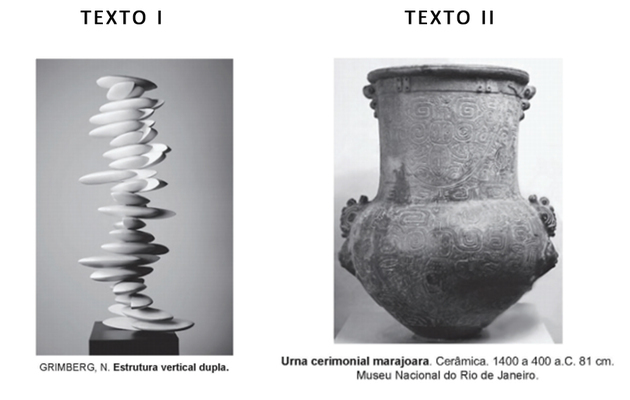
Both images are productions that use ceramics as their raw material. The work double vertical structure distinguishes itself from the Marajoara funeral urn to the
a) highlight the symmetry in the arrangement of the pieces.
b) materialize the technique without a utilitarian function.
c) abandon regularity in composition.
d) cancel out possibilities of affective readings.
e) integrate the support in its constitution.
Correct alternative: b) materialize the technique without a utilitarian function.
In the sculptural work presented in TEXT I, ceramics are presented as a support for art with an aesthetic and conceptual characteristic, without a utilitarian function. In TEXT II, the Marajoara funerary urn has the function of containing the mortal remains of a human being, therefore having a practical purpose in the society in which it was produced.
a) INCORRECT. The work Vertical Structure it does not have symmetrical shapes, on the contrary. Note that it exhibits shapes as if they were "stacked stones" that are laid out in an uncluttered and asymmetrical way.
c) INCORRECT. Although the work abandons regularity, this is not what makes it stand out from the Marajoara piece, what stands out as a differential is its non-utilitarian function.
d) INCORRECT. It is not because the work has characteristics of conceptual art that it does not have the possibility of affective readings. The interpretation of art is up to the public and generally each one arouses different interpretations, including affective ones.
e) INCORRECT. The work does not integrate the support in its composition.
question 6
(Enem-2017/adapted)
TEXT I
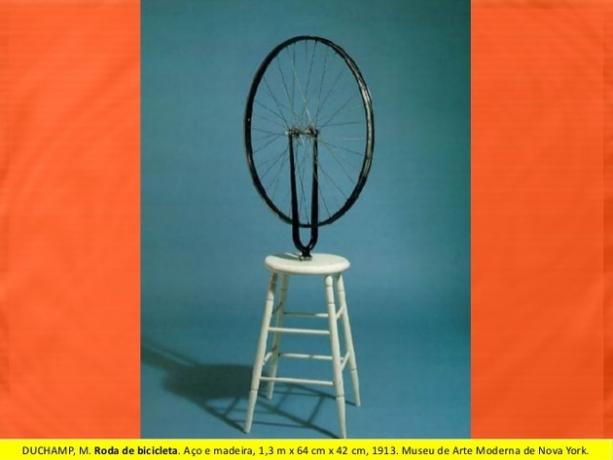
TEXT II
When asked about his ready-made creation process, Marcel Duchamp stated:
— This depended on the object; in general, you had to be careful with your look. It's very difficult to choose an object because after a fortnight you start to like it or hate it. You have to come to anything with such indifference that you don't have any aesthetic emotion. The choice of ready-made is always based on visual indifference and, at the same time, on a total absence of good or bad taste.
CABANNE, P.Marcel Duchamp: lost time engineer. São Paulo: Perspectiva, 1987 (adapted).
Relating the text and the image of the work, it is understood that the artist Marcel Duchamp, when creating the ready-mades, inaugurated a way of making art that consists of:
a) assigning to the avant-garde artist the task of being the artificer of the 20th century.
b) consider the shape of objects as an essential element of the work of art.
c) radically revitalize the classic concept of beauty in art.
d) criticize the principles that determine what a work of art is.
e) attribute to industrial objects the status of a work of art.
Correct alternative: d) criticize the principles that determine what a work of art is.
Duchamp was part of the Dada avant-garde movement, which had as one of its principles to question the work of art as an "anti-art" attitude. Therefore, when placing an object previously produced in an exhibition hall, the artist questions the reasons that point to and define what is or is not a work of art.
a) INCORRECT. The term "craftsman" refers to the artisan or artist. Marcel Duchamp did not intend to make the avant-garde artists the "only" or the "references" of 20th century art, but rather to innovate in ideas and bring reflections to the fore.
b) INCORRECT. Duchamp's intention was not related to the form of objects, much less to dictate what was essential to the art or not.
c) INCORRECT. The concern was not to bring a new concept of beauty, what he proposed was to question it, as well as to question art itself.
e) INCORRECT. Nor did he have as a goal to necessarily transform industrial objects into art, however he used some of them to question the concept of art.
question 7
(Enem-2017)
TEXT I

TEXT II
In the summer of 1954, the artist Robert Rauschenberg (n. 1925) created the term Match to refer to his new works that possessed aspects of both painting and sculpture. In 1958, Cama was selected to be included in an exhibition of young American and Italian artists at the Festival of the Two Worlds in Spoleto, Italy.
Those responsible for the festival, however, refused to exhibit the work and removed it to a deposit. While the art world debated the innovation of hanging a bed on a wall, Rauschenberg considered it his. work “one of the most welcoming paintings I've ever painted, but I was always afraid that no one wanted to get in in it”.
DEMPSEY. THE. Styles, Schools and Movements: Encyclopedic Guide to Modern Art. São Paulo: Cosac & Naify. 2003.
Rauschenberg's work shocked the public at the time it was made and was strongly influenced by an artistic movement that was characterized by:
a) dissolution of shades and contours, revealing rapid production.
b) unusual exploration of everyday elements, dialoguing with ready-mades.
c) exhaustive repetition of visual elements, leading to maximum simplification of the composition.
d) incorporation of technological changes, valuing the dynamism of modern life.
e) geometrical shapes, diluting the details without worrying about fidelity to reality.
Correct alternative: b) unusual exploration of everyday elements, dialoguing with ready-mades.
The ready-made is an expression of art that uses everyday objects that have already been produced by other people, usually with some utilitarian function. In the artistic context, the artist appropriates such objects, giving new meaning to them.
a) INCORRECT. The artist does not propose to dissolve contours and tones, but to explore elements of daily life.
In the work presented, Rauscheberg uses a bed as a support for his art, exploring in an unusual way this object so present in people's lives.
c) INCORRECT. There is no repetition of elements in Rausehenberg's work. This feature was part of the pop art movement.
d) INCORRECT. These are peculiarities of the futurist avant-garde, which is not related to the aforementioned work.
e) INCORRECT. The geometricization of shapes is characteristic of Cubism, which is not linked to the work presented.
question 8
(Enem-2017)
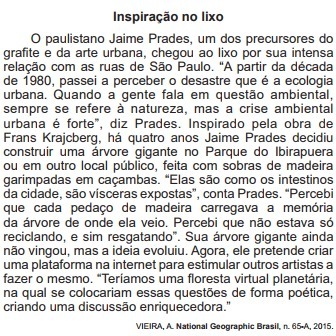
The text shades some transformations in the functions of art today. In the work cited, by artist Jaime Prades, the
a) reflection on man's environmental responsibility.
b) valorization of poetics over content.
c) concern with the beauty found in nature.
d) perception of the work as a support for memory.
e) reuse of garbage as a form of consumption.
Correct alternative: a) reflection on man's environmental responsibility.
The artist seeks to raise questions about the environmental crisis. This is clear in the text excerpt "(...) I came to realize the disaster that urban ecology is. When we talk about the environmental issue we always refer to nature, but the urban environmental crisis is strong."
b) INCORRECT. The artist proposes questions and reflections, combining content with poetics.
c) INCORRECT. The artist's concern is not necessarily with the beautiful, but with bringing out reflections on ecology.
d) INCORRECT. The work does not intend to address issues related to memory, the proposal is to discuss the environmental impact.
e) INCORRECT. The artist does not seek consumption through garbage, his concern is to raise reflections.
question 9
(Enem-2017)

In 1956, the artist Flávio de Resende Carvalho paraded along Avenida Paulista with the New Look costume, a tropical proposal for the men's wardrobe. His best known works are related to performances. The image allows us to list as characteristics of this artistic expression the use:
a) of intimacy, politics and the body.
b) the audience, irony and pain.
c) urban space, intimacy and drama.
d) fashion, drama and humor.
e) the body, provocation and fashion.
Correct alternative: e) body, provocation and fashion.
The artist uses fashion with the aim of bringing a new clothing proposal to men; he uses his body as an instrument and support to communicate through art; and it also uses provocation because it proposes a type of costume that was not used by men, but considered "female clothing".
a) INCORRECT. We cannot say that intimacy is related here to Flávio de Carvalho's performance.
b) INCORRECT. The "pain" element here is not worked.
c) INCORRECT. Intimacy and drama are not elements that the artist used either.
d) INCORRECT. Drama is not a feature of the aforementioned performance.
question 10
(Enem-2017)

TEXT II
In his production, Goeldi sought to reflect his personal and political path, his melancholy and passion about the intense, more latent aspects in his work, such as: cities, fish, vultures, skulls, abandonment, loneliness, drama and fear.
ZULIETTI, L. F. Goeldi: from melancholy to the inevitable. Magazine of Art, Media and Politics. Accessed on: April 24 2017 (adapted).
Engraver Oswaldo Goeldi was influenced by a European artistic movement from the beginning of the 20th century, which presents the characteristics revealed in the traces of the work of:


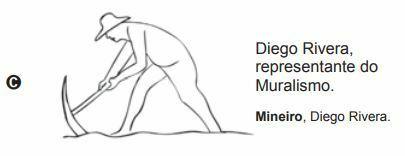

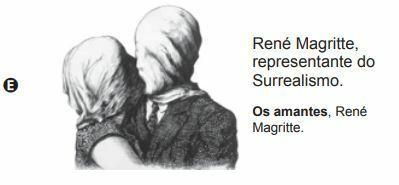
Correct alternative: a) Alfred Kubin, representative of expressionism.
The expressionist avant-garde had as characteristics the valorization of deep themes inherent to the human being, such as fear, loneliness, anguish and abandonment. All these subjects were much discussed in the work of Oswald Goeldi.
b) INCORRECT. In Fauvism, the characteristics are based on chromatic intensity, simplification of shapes and arbitrary use of colors.
c) INCORRECT. Mexican muralism brought other concerns, above all political ones, with a strong commitment to transmitting libertarian sentiments.
d) INCORRECT. In Cubism, what mattered was the geometry of the figures, placing the pictorial representation in a fragmented way.
e) INCORRECT. In surrealism, artists sought to bring unusual elements into their works, with many references in the universe of dreams and psychoanalysis.
You may also be interested:
- European vanguards
- Exercises on European Vanguards
question 11
(Enem-2017)
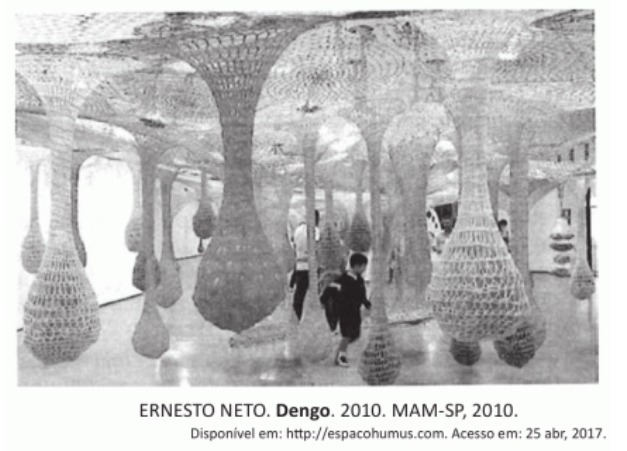
The installation dengo transformed the MAM-SP room into a unique environment, exploring as its main artistic characteristic:
a) public participation in the playful interaction with the work.
b) distribution of obstacles in the exhibition space.
c) symbolic representation of dream objects.
d) subjective interpretation of the law of gravity
e) enhancement of craft techniques.
Correct alternative: a) public participation in playful interaction with the work.
Installation is a type of art in which the environment is used to encompass artistic productions. In this work by Ernesto Neto, we can observe crochet structures hanging from the ceiling and occupying the room, where visitors can interact. The presence of children moving between these structures is noted, which highlights the interactive nature of the work.
b) INCORRECT. The elements of the work cannot be considered "obstacles", as they are there precisely for the purpose of interacting with the public.
c) INCORRECT. The objects used do not necessarily represent the oneiric universe, that is, dreams.
d) INCORRECT. Ernesto Neto does not propose to interpret gravity, but to provide playful experiences.
e) INCORRECT. The alternative could be considered partially correct, since the production is made in crochet, a handcraft technique widely produced in Brazil. However, when it comes to "artistic characteristic", the statement of the letter A is more correct.
question 12
(Enem-2017)
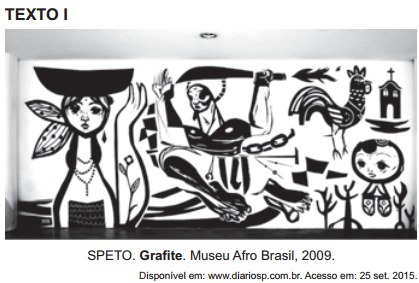
TEXT II
Skewer
Paulo César Silva, better known as Speto, is a graffiti artist from São Paulo involved with skateboarding and music. The strengthening of his art occurred in 1999, due to the opportunity to see up close the references that brought it for some time, when passing through several cities in the North of Brazil on a tour with the band O Rappa.
Zupi Magazine, no. 19, 2010
The graffiti by São Paulo artist Speto, exhibited at the Afro Brasil Museum, reveals recognized elements of Brazilian culture:
a) the influence of abstract expression.
b) in the representation of national legends.
c) in the inspiration of musical compositions.
d) in the lines marked by the northeastern woodcut.
e) in the characteristic uses of skateboard graphics.
Correct alternative: d) in the lines marked by the northeastern woodcut.
Woodcuts are an artistic expression very present in northeastern culture, allied mainly with cordel literature - leaflets printed with rhymed verses.
a) INCORRECT. The artist does not use abstract art as inspiration, which can be seen through the figurative elements of his work.
b) INCORRECT. Here there is no representation of national legends, but of common figures present in the Brazilian people, especially from the Northeast.
c) INCORRECT. It is not possible to perceive the relationship between music and Speto's work.
To make woodcuts, it is necessary to produce a matrix carved in wood, which is then "stamped" on paper. Outstanding features of this art form are the thick lines and contrast.
In the case of northeastern woodcuts, popular themes are also valued. All these elements are present in the work of Speto, the aforementioned artist.
e) INCORRECT. Skateboarder culture is not evident in Speto's work, despite his involvement with skateboarding.
question 13
(Enem - 2016)

The décollage technique, used by artist Mimmo Rotella in his work Marilyn, is an artistic procedure representative of the 1960s by:
a) aim at the conservation of representations and visual records.
b) be based on the recycling of graphic material, contributing to sustainability.
c) cover up the past, opening the way for new plastic forms, through rereading.
d) make different fields of expression coexist and integrate new meanings.
e) abolish the artist's manual work in the confection of recontextualized images.
Correct alternative: d) make different fields of expression coexist and integrate new meanings.
Decollage is a technique that consists of applying surfaces on top of each other and then “peeling off” layers of paper in order to reveal the surfaces that are hidden. Thus, it is a different procedure from collage, but one that is related to it and is also intended to combine different types of communication and expression, bringing new interpretations.
a) INCORRECT. There is no intention to keep the visual language in force at the time, but to bring new ways of representations.
b) INCORRECT. Artists actually used existing graphic materials, such as advertising posters, but the idea was not based on sustainability, but on an aesthetic innovation.
c) INCORRECT. Despite seeking new imagery meanings, artists did not necessarily aim to cover up the past.
e) INCORRECT. The décollage is done using, above all, manual work.
question 14
(Enem - 2019)
In order for the transition from the uninterrupted production of novelty to its consumption to be carried out continuously, mechanisms and gears are needed.
A kind of great industrial machine, inciting, tentacular, comes into action. But very quickly the simple law of supply and demand according to needs is no longer valid: it is necessary to excite the demand, to excite the event, to provoke it, to provoke it, to manufacture it, because modernity becomes feeds on it.
CAUQUELIN, A. Contemporary art: an introduction. São Paulo: Martins Fontes, 2005 (adapted).
In the context of contemporary art, the text by author Anne Cauquelin reflects actions that explain:
a) methods used by the art market.
b) investments made by patrons.
c) interests of the art consumer.
d) the artist's daily practices.
e) public support for culture.
Correct alternative: a) methods used by the art market.
The author of the text seeks to explain the motivations of the art market in search of new needs.
b) INCORRECT. Nowadays, the term “maecenas” is no longer used, however, there is still cultural sponsorship. However, the text does not address this aspect, it is possible to see this in the passage “great industrial machine, inciting, tentacular, comes into action”.
c) INCORRECT. The subject is not about consumer actions, but about the industry.
d) INCORRECT. The artists' creative processes and their practices do not come into question in Anne Cauquelin's speech. The author does not mention this point at any time.
e) INCORRECT. The text addresses the motivations for creating new content, not the financing of culture.
question 15
(Enem 2015)
In the exhibition “The Artist is Present”, at MoMa, in New York, the performer Marina Abramovic made a retrospective of her career. In the middle of this, she starred in a remarkable performance. In 2010, from March 14th to May 31st, six days a week, for a total of 736 hours, she repeated the same posture. Sitting in a room, she received visitors, one by one, and exchanged a long, wordless look with each of them. All around, the audience watched these recurring scenes.
ZANIN, L. Marina Abramovic, or the power of the gaze. Available in: http://blogs.estadao.com.br. Accessed on: Nov. 4 2013.
The text presents a work by artist Marina Abramovic, whose performance is in line with contemporary trends and is characterized by:
a) innovation of a relational art proposal that enters a museum.
b) educational approach established in the artist's relationship with the public.
c) redistribution of the museum's space, which integrates different artistic languages.
d) Collaborative negotiation of meanings between the artist and the person with whom she interacts
e) approximation between artist and audience, which breaks with the elitization of this art form.
Correct alternative: d) Collaborative negotiation of meanings between the artist and the person with whom she interacts
In this performance, Marina seeks a connection with people through her eyes. It is necessary for the public to collaborate and be willing to exchange, which occurs in the realm of the senses and emotions.
a) INCORRECT. Even though it is a relational art, Marina's performance does not bring an innovation in this approach within the museum, as many works have already been made bringing similar objectives with regard to the aspect relational.
b) INCORRECT. Marina Abramovic's approach has no educational intent, as it takes place in a more subtle and subjective terrain.
c) INCORRECT. The artist does not seek the redistribution of space either. In reality, the proposal is a personal connection, space is not among the artist's concerns in this performance.
e) INCORRECT. Although the approximation between the artist and the audience is the objective of the work, she does not necessarily manage to break with the elitization, since there is still a great distance between the museum environment and most of the population.
To learn more about careers, Enem and entrance exams, read also:
- Arts in Enem
- Courses for art lovers

